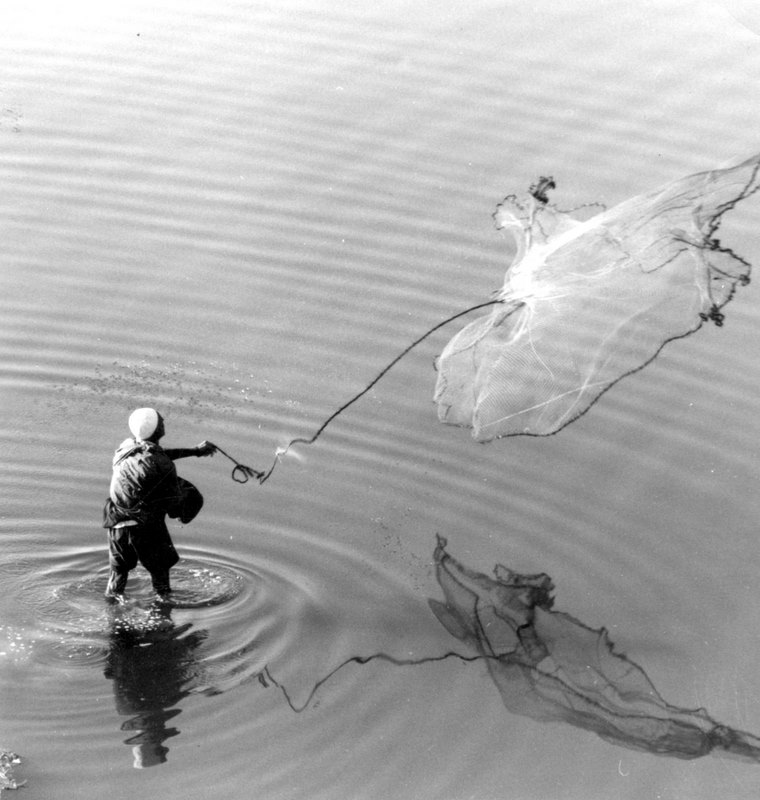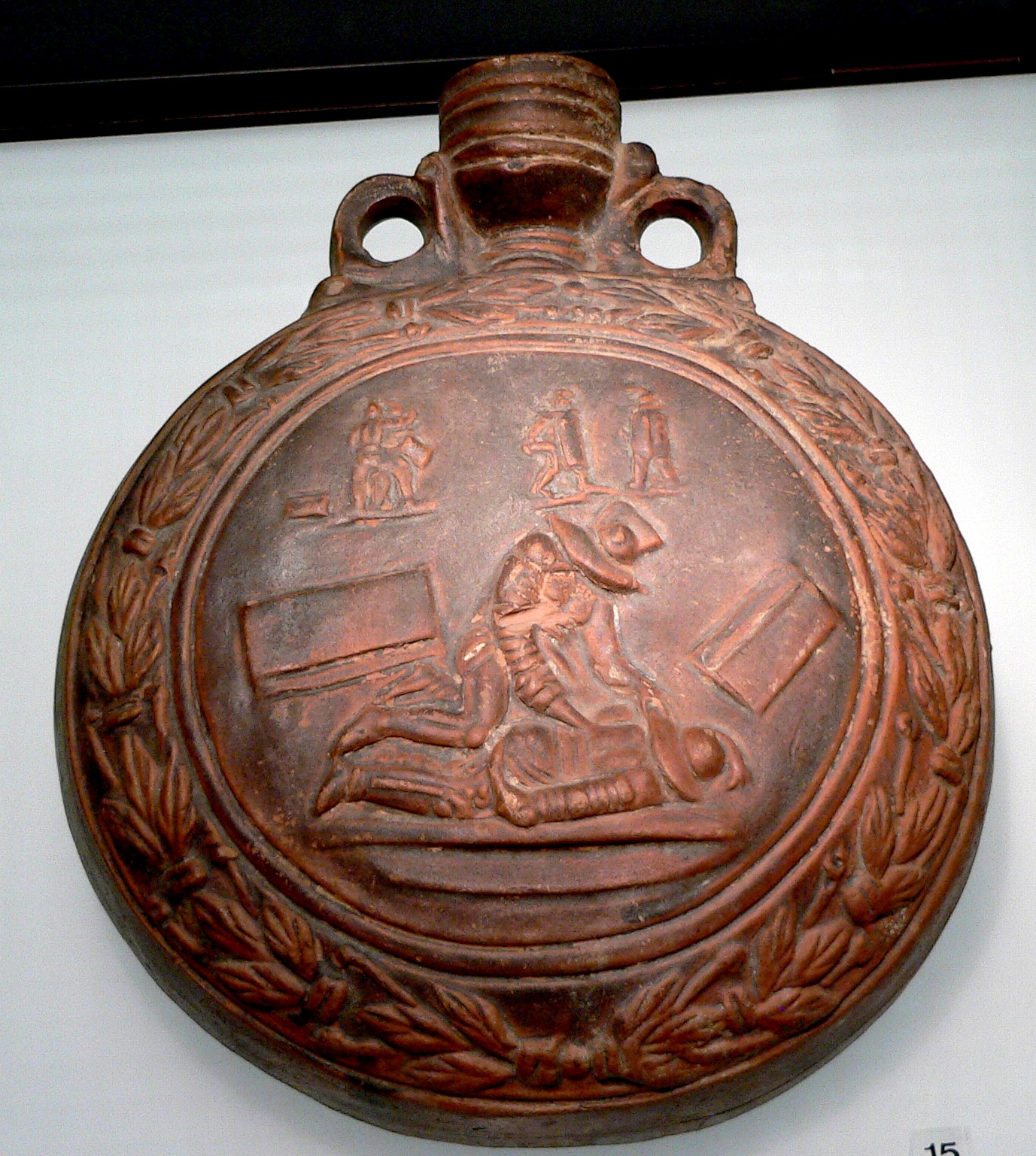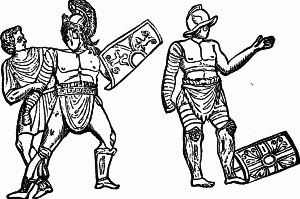|
Retiarius
A ''retiarius'' (plural ''retiarii''; literally, "net-man" in Latin) was a Roman gladiator who fought with equipment styled on that of a fisherman: a weighted net (''rete'' (3rd decl.), hence the name), a three-pointed trident (''fuscina'' or ''tridens''), and a dagger (''pugio''). The ''retiarius'' was lightly armoured, wearing an arm guard ('' manica'') and a shoulder guard (''galerus''). Typically, his clothing consisted only of a loincloth (''subligaculum'') held in place by a wide belt, or of a short tunic with light padding. He wore no head protection or footwear. The ''retiarius'' was routinely pitted against a heavily armed '' secutor''. The net-fighter made up for his lack of protective gear by using his speed and agility to avoid his opponent's attacks and waiting for the opportunity to strike. He first tried to throw his net over his rival. If this succeeded, he attacked with his trident while his adversary was entangled. Another tactic was to ensnare his enemy's wea ... [...More Info...] [...Related Items...] OR: [Wikipedia] [Google] [Baidu] |
List Of Roman Gladiator Types
There were many different types of gladiators in ancient Rome. Some of the first gladiators had been prisoners-of-war, and so some of the earliest types of gladiators were experienced fighters; Gauls, Samnites, and ''Thraeces'' (Thracians) used their native weapons and armor. Different gladiator types specialized in specific weapons and fighting techniques. Combatants were usually pitted against opponents with different, but more or less equivalent equipment, for the sake of a fair and balanced contest. Most gladiators only fought others from within the same school or ''ludus'', but sometimes specific gladiators could be requested to fight one from another ''ludus''. Elite gladiators wore high-quality decorative armour for the pre-game parade ''(Pompa)''. Julius Caesar's gladiators wore silver armour, Domitian's wore golden armour and Nero's wore armour decorated with carved amber. Peacock feathers were used for plumes while tunics and loincloths had patterns in gold thread. For t ... [...More Info...] [...Related Items...] OR: [Wikipedia] [Google] [Baidu] |
Secutor
A secutor (''pl.'' secutores) was a class of gladiator in ancient Rome. Thought to have originated around 50 AD, the secutor ("follower" or "chaser", from ''sequor'' "I follow, come or go after") was armed similarly to the Murmillo gladiator and like the Murmillo, was protected by a heavy shield. A secutor usually carried a short sword, a gladius, or a dagger. The secutor was specially trained to fight a retiarius, a type of lightly armoured gladiator armed with a trident and net. Equipment The secutor wore a ''subligaculum'' (loincloth), and a '' balteus'' (a wide belt much like that of the retiarius). On his right arm he wore a '' manica'' (a heavy linen or metal wrapping tied with leather thongs). On his left leg he wore an ''ocrea'' (a greave made of boiled leather or metal). He also carried a '' scutum'' (a curved rectangular shield) to protect himself. The very distinctive helmet of the secutor had only two small eye-holes, in order to prevent a retiarius' trident from ... [...More Info...] [...Related Items...] OR: [Wikipedia] [Google] [Baidu] |
Gladiator
A gladiator ( la, gladiator, "swordsman", from , "sword") was an armed combatant who entertained audiences in the Roman Republic and Roman Empire in violent confrontations with other gladiators, wild animals, and condemned criminals. Some gladiators were volunteers who risked their lives and their legal and social standing by appearing in the arena. Most were despised as slaves, schooled under harsh conditions, socially marginalized, and segregated even in death. Irrespective of their origin, gladiators offered spectators an example of Rome's martial ethics and, in fighting or dying well, they could inspire admiration and popular acclaim. They were celebrated in high and low art, and their value as entertainers was commemorated in precious and commonplace objects throughout the Roman world. The origin of gladiatorial combat is open to debate. There is evidence of it in funeral rites during the Punic Wars of the 3rd century BC, and thereafter it rapidly became an essential fe ... [...More Info...] [...Related Items...] OR: [Wikipedia] [Google] [Baidu] |
Net Casting
A casting net, also called a throw net, is a net used for fishing. It is a circular net with small weights distributed around its edge. The net is cast or thrown by hand in such a manner that it spreads out while it's in the air before it sinks into the water. This technique is called net casting or net throwing. Fish are caught as the net is hauled back in.Dunbar This simple device is particularly effective for catching small bait or forage fish, and has been in use, with various modifications, for thousands of years. __TOC__ Construction and technique Contemporary cast nets have a radius which ranges from 4 to 12 feet (1.2 to 3.6 metres). Only strong people can lift the larger nets once they are filled with fish. Standard nets for recreational fishing have a four-foot hoop. Weights are usually distributed around the edge at about one pound per foot (1.5 kilograms per metre). Attached to the net is a handline, one end of which is held in the hand as the net is thrown. W ... [...More Info...] [...Related Items...] OR: [Wikipedia] [Google] [Baidu] |
Murmillo
The murmillo (also sometimes spelled "mirmillo" or "myrmillo", pl. murmillones) was a type of gladiator during the Roman Imperial age. The murmillo-class gladiator was adopted in the early Imperial period to replace the earlier Gallus, named after the warriors of Gaul. As the Gauls inhabiting Italy had become well integrated with the Romans by the time of the reign of Augustus, it became undesirable to portray them as enemy outsiders; the Gallus-class gladiator thus had to be retired. Equipment and armaments The murmillo was armed with: *Gladius: Roman sword with a length of 64–81 cm and weight of 1.2-1.6 kg with a handle made of bone. * Scutum: Rectangular shield made of vertically connected wooden boards with a small bronze boss which protects the shield's handle. * Balteus: Leather belt with metal decorations and supplements. Similar to current boxing belts. * Manica: Segmented or scaled arm guard made of leather or some metal alloys. Manicae can also be mai ... [...More Info...] [...Related Items...] OR: [Wikipedia] [Google] [Baidu] |
Laquearius
The ''laquearius'', ''laquerarius'', or ''laqueator'' (plural ''laquearii'', ''laquerarii'', and ''laqueatores''; literally, "snarer") was a class of Ancient Rome, Roman gladiator that fought with a lasso or noose (''laqueus'') in one hand and a poniard or sword in the other.Tegg 485.Cowper 215. The ''laquearius'' appeared late in the history of the Roman games. They may have made up a full-fledged gladiator class that fought actual bouts in the arena. If this was the case, the snarer likely followed the same tactics as the ''retiarius'', a gladiator who wielded a Cast net, throwing net and posiedon.Junkelmann 63. Such combat-oriented ''laquearii'' fought by attempting to snare their adversaries with the lasso to allow for a follow-up strike from the blade. The snarer's armour was probably similar to that of the ''retiarius''; it consisted mainly of a ''retiarius'' armguard worn over the left shoulder. Another possibility is that the ''laquearius'' was a kind of ''paegniarius'', or cl ... [...More Info...] [...Related Items...] OR: [Wikipedia] [Google] [Baidu] |
Trident
A trident is a three- pronged spear. It is used for spear fishing and historically as a polearm. The trident is the weapon of Poseidon, or Neptune, the God of the Sea in classical mythology. The trident may occasionally be held by other marine divinities such as Tritons in classical art. Tridents are also depicted in medieval heraldry, sometimes held by a merman-Triton. In Hinduism, it is the weapon of Shiva, known as ''trishula'' (Sanskrit for "triple-spear"). Etymology The word "trident" comes from the French word ''trident'', which in turn comes from the Latin word ' or ': ''tri'' meaning "three" and ''dentes'' meaning "teeth", referring specifically to the three prongs, or "teeth", of the weapo The Greek language, Greek equivalent is (''tríaina''), from Proto-Greek ''trianja'', meaning "threefold". The Greek term does not imply three of anything specific, and is vague about the shape, thus the assumption it was originally of "trident" form has been challenged. Latin ... [...More Info...] [...Related Items...] OR: [Wikipedia] [Google] [Baidu] |
Samnite (gladiator Type)
A Samnite (Latin ''Samnis'', plural ''Samnites'') was a Roman gladiator who fought with equipment styled on that of a warrior from Samnium: a short sword (''gladius''), a rectangular shield ('' scutum''), a greave (ocrea), and the helmet. Warriors armed in such a way were the earliest gladiators in the Roman games. They appeared in Rome shortly after the defeat of Samnium in the 4th century BC, apparently adopted from the victory celebrations of Rome's allies in Campania. By arming low-status gladiators in the manner of a defeated foe, Romans mocked the Samnites and appropriated martial elements of their culture. Samnites were quite popular during the period of Roman Republic. Eventually, other gladiator types joined the roster, such as the murmillo and the Thraex. Under the reign of Emperor Augustus, Samnium became an ally and integral part of the Roman Empire (all Italians had by this point gained Roman citizenship). The Samnite was replaced by similarly armed gladiators, incl ... [...More Info...] [...Related Items...] OR: [Wikipedia] [Google] [Baidu] |
Pompeii
Pompeii (, ) was an ancient city located in what is now the ''comune'' of Pompei near Naples in the Campania region of Italy. Pompeii, along with Herculaneum and many villas in the surrounding area (e.g. at Boscoreale, Stabiae), was buried under of volcanic ash and pumice in the Eruption of Mount Vesuvius in 79 AD. Largely preserved under the ash, the excavated city offered a unique snapshot of Roman life, frozen at the moment it was buried, although much of the detailed evidence of the everyday life of its inhabitants was lost in the excavations. It was a wealthy town, with a population of ca. 11,000 in AD 79, enjoying many fine public buildings and luxurious private houses with lavish decorations, furnishings and works of art which were the main attractions for the early excavators. Organic remains, including wooden objects and human bodies, were interred in the ash. Over time, they decayed, leaving voids that archaeologists found could be used as moulds to make plast ... [...More Info...] [...Related Items...] OR: [Wikipedia] [Google] [Baidu] |
Roman Empire
The Roman Empire ( la, Imperium Romanum ; grc-gre, Βασιλεία τῶν Ῥωμαίων, Basileía tôn Rhōmaíōn) was the post- Republican period of ancient Rome. As a polity, it included large territorial holdings around the Mediterranean Sea in Europe, North Africa, and Western Asia, and was ruled by emperors. From the accession of Caesar Augustus as the first Roman emperor to the military anarchy of the 3rd century, it was a Principate with Italia as the metropole of its provinces and the city of Rome as its sole capital. The Empire was later ruled by multiple emperors who shared control over the Western Roman Empire and the Eastern Roman Empire. The city of Rome remained the nominal capital of both parts until AD 476 when the imperial insignia were sent to Constantinople following the capture of the Western capital of Ravenna by the Germanic barbarians. The adoption of Christianity as the state church of the Roman Empire in AD 380 and the fall of th ... [...More Info...] [...Related Items...] OR: [Wikipedia] [Google] [Baidu] |
Chieti
Chieti (, ; , nap, label= Abruzzese, Chjïétë, ; gr, Θεάτη, Theátē; lat, Theate, ) is a city and ''comune'' (municipality) in Central Italy, east by northeast of Rome. It is the capital of the province of Chieti in the Abruzzo region. In Italian, the adjectival form is ''teatino'' and inhabitants of Chieti are called ''teatini''. The English form of this name is preserved in that of the Theatines, a Catholic religious order. History Mythological origins and etymology Chieti is among the most ancient of Italian cities. According to mythological legends, the city was founded by the fellows of Achilles and was named in honor of his mother, Thetis. Other traditions attribute the foundation to Greeks after the destruction of Troy, to Hercules or a queen of Pelasgians. According to Strabo, it was founded by the Arcadians as Thegeate (Θηγεάτη), named after Tegea. It was called Theate ( gr, Θεάτη) (or Teate in Latin). As Theate Marrucinorum, Chieti was th ... [...More Info...] [...Related Items...] OR: [Wikipedia] [Google] [Baidu] |
.jpg)







